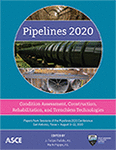Pipelines 2020
VOC Mitigation Device for CIPP Exhaust
Publication: Pipelines 2020
ABSTRACT
The research presented in this paper seeks to provide the CIPP industry with an option to eliminate the need for a safety perimeter and most personal protective equipment by destroying the VOC emissions at the liner termination point. Such a device would put the user on the leading edge of continually improving air quality and safety efforts in this valuable worldwide industry. This paper investigates VOC emissions in other industries and explores existing mitigation techniques created to meet the unique needs of those industries. Beyond a review of existing technologies, this paper outlines ongoing research at the Louisiana Tech University Trenchless Technology Center in Ruston, Louisiana, to provide the CIPP industry with a basis of design for a VOC mitigation device that will eliminate over 90% of the volatile organic compounds in the CIPP exhaust on the installation site at the termination manhole.
Get full access to this article
View all available purchase options and get full access to this chapter.
REFERENCES
AirZone Inc., 2001. A Report on the Monitoring of Styrene in Toronto Homes During the Cured In Place Pipe (CIPP) Process for Sewer Pipe Rehabilitation by Insituform. AirZone, Inc., Toronto.
Bauer, G. & McCartney, D., 2004. Odour Control-More Than Sewage When Installing Cured-In-Place Sewer Pipe. Proc. North American Society for Trenchless Technology (NASTT) NO-DIG Conf., NASTT, Paper D-3-02, Liverpool, N.Y.
EPA (2008). Styrene: Interim Acute Exposure Guideline Levels (AEGLs). Retrieved online from https://www.epa.gov/sites/production/files/201408/documents/styrene_interim_feb_2008.v1.pdf.
Institute for Underground Infrastructure – IKT (2004). Investigation of the styrene emissions associated with sewage pipe rehabilitation.
Najafi, M., Sattler, M., Schug, K., Kaushal, V., Korky, S., Iyer, G., … Farazifard, R. (2018). Evaluation of potential release of organic chemicals in the steam exhaust and other release points during pipe rehabilitation using the trenchless Cured-In-Place Pipe (CIPP) method. Center for Underground Infrastructure Research and Education (CUIRE), The University of Texas at Arlington, Arlington, TX.
NIOSH. (2019). NIOSH Pocket Guide to Chemical Hazards. Website accessed on December 30th, 2019 at https://www.cdc.gov/niosh/npg/pgintrod.html.
OSHA. (2019). Permissible Exposure Limits – Annotated Tables. Website accessed December 30th, 2019 at https://www.osha.gov/dsg/annotated-pels/index.html.
Sendesi, S., Ra, K., Conkling, E., Boor, B., Nuruddin, M., Howarter, J., Youngblood, J., Kobos, L., Shannahan, J., Jafvert, C. and Whelton, A. (2017). “Worksite chemical air emissions and worker exposure during sanitary sewer and stormwater pipe rehabilitation using cured-in-place-pipe (CIPP).” Environmental Science & Technology Letters, 4(8), 325-333.
EPA (2019). Air Pollution Control Technology Fact Sheet – Thermal Incinerator (EPA-452/F-03-022) Retrieved from: https://www3.epa.gov/ttncatc1/cica/atech_e.html.
EPA (2019). Air Pollution Control Technology Fact Sheet Catalytic Incinerator (EPA-452/F-03-018) Retrieved from: https://www3.epa.gov/ttncatc1/cica/atech_e.html.
EPA (2019). EPA Air Pollution Control Cost Manual, Sixth Edition (EPA/452/B-02-001) Retrieved from: https://www3.epa.gov/ttncatc1/dir1/c_allchs.pdf.
Kamal, M., Razzak, S., Hossain, M., Catalytic Oxidation of Volatile Organic Compounds – A review, Atmospheric Environment, Volume 140, 2016, ISSN 1352-2310, https://doi.org/10.1016/j.atmosenv.2016.05.031.
Wu, J., Chang, T., VOC Deep Oxidation Over Pt Catalysts Using Hydrophobic Supports, Catalysis Today, Volume 44, Issues 1–4, 1998, Pages 111–118, ISSN 0920-5861, https://doi.org/10.1016/S0920-5861(98)00179-5.
Bradley & Associates (2005). Best Available Technology for Air Pollution Control: Analysis Guidance and Case Studies for North America. Prepared for: Commission for Environmental Cooperation (CEC) of North America. Retrieved from: http://www3.cec.org.
Kong, E., M. Bahner, S. Turner. Assessment of Styrene Emission Controls for FRP/C and Boat Building Industries., 1996.
Sendilvelan, S, K. Jeyachandran, K. Bhaskar. 2001. Pollution Studies on Gasoline Engine with Electrically Heated Catalyst. 2001 Spring Technical Conference, IC Engine Division of ASME. 36-1: 95–99.
Domínguez, M.I., Pérez, A., Centeno, M.A., Odriozola, J.A. Metallic Structured Catalysts: Influence of the Substrate on the Catalytic Activity. Applied Catalyst. 2014, 478, 45–57.
Avila, P., Montes, M., Miró, E., Monolithic Reactors for Environmental Applications: A Review of Preparation Technologies, Chemical Engineering Journal, Volume 109, Issues 1–3, 2005, Pages 11–36, ISSN 1385-8947.
Information & Authors
Information
Published In
Pipelines 2020
Pages: 411 - 419
Editors: J. Felipe Pulido, OBG, Part of Ramboll and Mark Poppe, Brown and Caldwell
ISBN (Online): 978-0-7844-8320-6
Copyright
© 2020 American Society of Civil Engineers.
History
Published online: Aug 6, 2020
Published in print: Aug 6, 2020
Authors
Metrics & Citations
Metrics
Citations
Download citation
If you have the appropriate software installed, you can download article citation data to the citation manager of your choice. Simply select your manager software from the list below and click Download.
